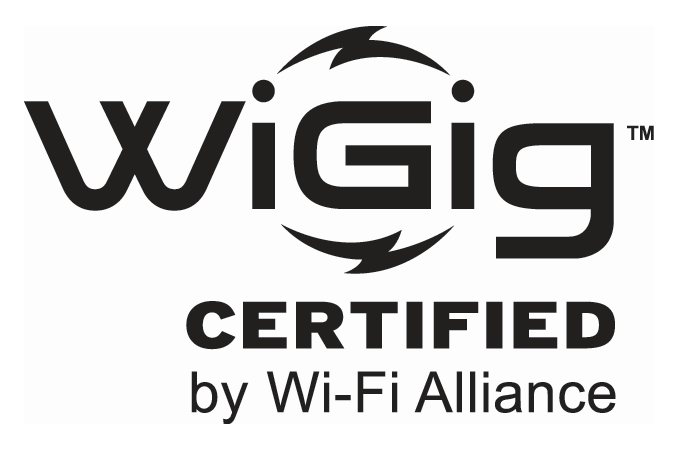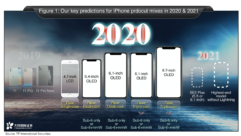As new rumors surface again that Apple will ditch all iPhone ports in favor of wireless everything, WiGig is back on the radar. But it’s not just important to devices; the specification supports the wireless transmission of AV data, including support for displays, cameras, and projectors, and for HDCP 2.0.
 WiGig refers to a set of 60 GHz wireless network protocols that specialize in delivering very fast wireless over short distances. Additionally the specification utilizes beamforming to propagate off reflections from walls, ceilings, floors, and objects, enabling multi-gigabit speeds at up to 10 meters. While it cannot go through walls at 60 GHz, the protocol switches to lower bands at lower rates to accommodate roaming from the main location. This open WiGig standard is in competition with the proprietary WirelessHD standard for some devices.
WiGig refers to a set of 60 GHz wireless network protocols that specialize in delivering very fast wireless over short distances. Additionally the specification utilizes beamforming to propagate off reflections from walls, ceilings, floors, and objects, enabling multi-gigabit speeds at up to 10 meters. While it cannot go through walls at 60 GHz, the protocol switches to lower bands at lower rates to accommodate roaming from the main location. This open WiGig standard is in competition with the proprietary WirelessHD standard for some devices.
WiGig is sometimes called 60GHz Wi-Fi and it includes the current IEEE 802.11ad standard and also the upcoming IEEE 802.11ay standard (currently in draft). Here are IEEE’s details on the Task Group and the meeting schedule.
The WiGig specification allows devices to communicate wirelessly at multi-gigabit speeds. That’s potentially important in AV because it supplements the capabilities of previous wireless LAN devices with high performance wireless data, display and audio. WiGig tri-band enabled devices, which operate in the 2.4, 5 and 60 GHz bands, deliver data transfer rates up to 7 Gbit/s (for 11ad), about as fast as an 8-band 802.11ac transmission, and more than 11 times faster than the highest 802.11n rate, while maintaining compatibility with existing Wi-Fi devices.
In 2010, things got interesting for AV when the WiGig Alliance announced the WiGig version 1.0 A/V and I/O protocol adaptation layer (PAL) specifications.
The name WiGig comes from Wireless Gigabit Alliance, the original association formed in 2009 to promote the adaption of IEEE 802.11ad. Board-level members included Intel, AMD, Broadcom, Qualcomm, Apple, Microsoft, Cisco, Dell, Huawei, NEC, NVIDIA, Panasonic, Sony, Samsung, Toshiba, and others. Contributing members from our industry included Harman, Rohde & Schwartz, and Texas Instruments.
In 2009, the WiGig Alliance announced its 1.0 spec; in 2010 the spec was published and the WiGig Alliance entered into its liaison agreement with the Wi-Fi Alliance. Also in 2010, things got interesting for AV when the WiGig Alliance announced the version 1.0 A/V and I/O protocol adaptation layer (PAL) specifications.
Here are some highlights as announced at the time.
WiGig Display Extension
- Supports wireless transmission of audio/visual data
- Enables wireless DisplayPort other display interfaces that include the High-bandwidth Digital Content Protection (HDCP) 2.0 feature.
- Offers key A/V applications, such as the transmission of lightly compressed or uncompressed video from a computer or digital camera to an HDTV, monitor or projector
WiGig Bus Extension and WiGig Serial Extension.
- Define high-performance wireless implementations of widely used computer interfaces over 60 GHz
- Enable multi-gigabit wireless connectivity between any two devices, such as connection to storage and other high-speed peripherals
In June 2011, the WiGig Alliance announced it’s completed certification version 1.1 and described the capabilities as follows:
- Data transmission rates up to 7 Gbit/s – a bit over eleven times as fast as the highest 802.11n rate
- Supplementation and extension of the 802.11 Media Access Control (MAC) layer and backward compatibility with the IEEE 802.11 standard
- Physical layer enables low power and high performance WiGig devices, guaranteeing interoperability and communication at gigabit per second rates
- Protocol adaptation layers were indicated to support specific system interfaces including data buses for PC peripherals and display interfaces for HDTVs, monitors and projectors
- Support for beamforming, enabling robust communication at up to 10 meters. The beams can move within the coverage area through modification of the transmission phase of individual antenna elements, which is called phase array antenna beamforming.
- Widely used advanced security and power management for WiGig devices.
In late 2012, IEEE published IEEE 802.11ad-2012 as an amendment to the overall IEEE 802.11 standard family.
In 2013, the Wi-Fi Alliance subsumed the WiGig Alliance and in 2016 began a certification program for WiGig. This is how they describe their implementation:
Wi-Fi CERTIFIED WiGig™ expands the Wi-Fi® experience for virtual reality, multimedia streaming, gaming, wireless docking, and enterprise applications requiring high speed, data-intensive connections. WiGig® allows Wi-Fi devices to access the uncongested 60 GHz frequency band with wide channels to transmit data efficiently at multi-gigabit per second speeds. Users benefit from expanded capacity and focused transmission between devices to reduce interference, even in crowded environments.
Popular uses for WiGig products include:
- Wireless docking between devices like smartphones, laptops, projectors, and tablets
- Simultaneous streaming of multiple, ultra-high definition videos and movies
- More immersive gaming, augmented reality and virtual reality experiences
- Fast download of HD movies
- Convenient public kiosk services
- Easier handling of bandwidth intensive applications in the enterprise
Expanded, multi-band capacity
WiGig complements the dual-band capability of Wi-Fi CERTIFIED™ ac by enabling use of a third, less congested frequency band at 60 GHz. This increases Wi-Fi network capability, allowing for extremely high transmission speeds. Multi-band Wi-Fi CERTIFIED WiGig devices can provide continuous connectivity with seamless transfer between the 2.4, 5, or 60 GHz bands, resulting in a high quality Wi-Fi experience.







